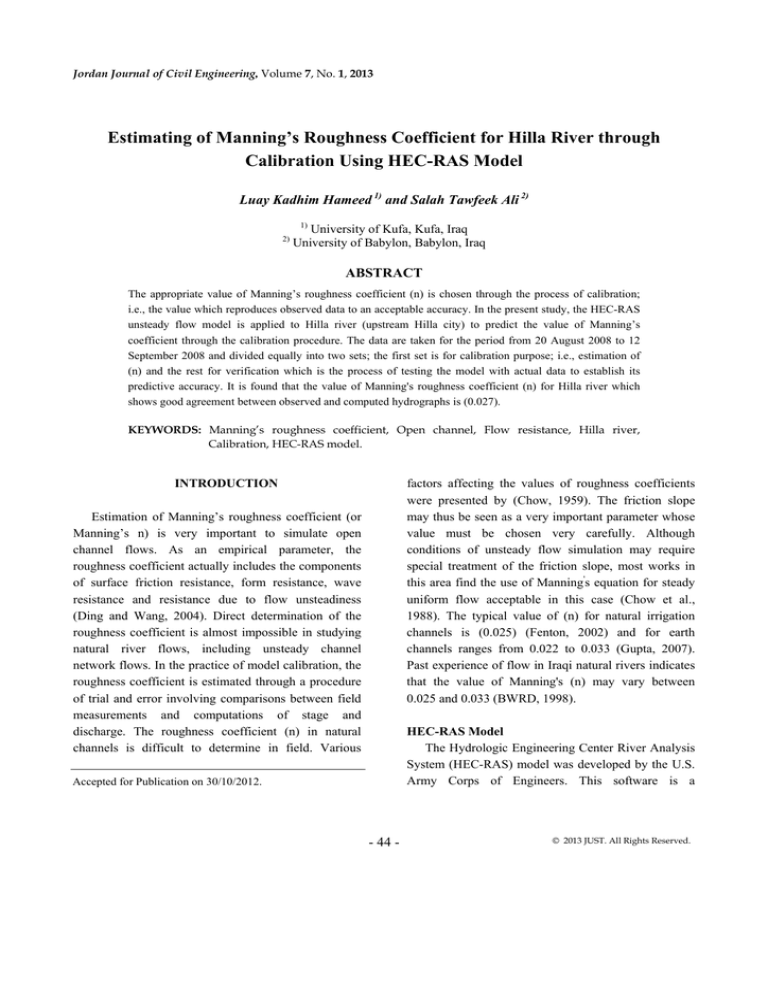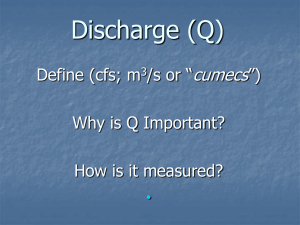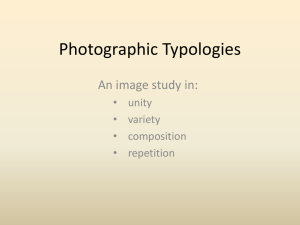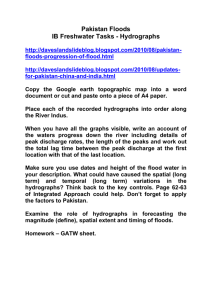
Jordan Journal of Civil Engineering, Volume 7, No. 1, 2013
Estimating of Manning’s Roughness Coefficient for Hilla River through
Calibration Using HEC-RAS Model
Luay Kadhim Hameed 1) and Salah Tawfeek Ali 2)
1)
2)
University of Kufa, Kufa, Iraq
University of Babylon, Babylon, Iraq
ABSTRACT
The appropriate value of Manning’s roughness coefficient (n) is chosen through the process of calibration;
i.e., the value which reproduces observed data to an acceptable accuracy. In the present study, the HEC-RAS
unsteady flow model is applied to Hilla river (upstream Hilla city) to predict the value of Manning’s
coefficient through the calibration procedure. The data are taken for the period from 20 August 2008 to 12
September 2008 and divided equally into two sets; the first set is for calibration purpose; i.e., estimation of
(n) and the rest for verification which is the process of testing the model with actual data to establish its
predictive accuracy. It is found that the value of Manning's roughness coefficient (n) for Hilla river which
shows good agreement between observed and computed hydrographs is (0.027).
KEYWORDS: Manning’s roughness coefficient, Open channel, Flow resistance, Hilla river,
Calibration, HEC-RAS model.
factors affecting the values of roughness coefficients
were presented by (Chow, 1959). The friction slope
may thus be seen as a very important parameter whose
value must be chosen very carefully. Although
conditions of unsteady flow simulation may require
special treatment of the friction slope, most works in
this area find the use of Manning's equation for steady
uniform flow acceptable in this case (Chow et al.,
1988). The typical value of (n) for natural irrigation
channels is (0.025) (Fenton, 2002) and for earth
channels ranges from 0.022 to 0.033 (Gupta, 2007).
Past experience of flow in Iraqi natural rivers indicates
that the value of Manning's (n) may vary between
0.025 and 0.033 (BWRD, 1998).
INTRODUCTION
Estimation of Manning’s roughness coefficient (or
Manning’s n) is very important to simulate open
channel flows. As an empirical parameter, the
roughness coefficient actually includes the components
of surface friction resistance, form resistance, wave
resistance and resistance due to flow unsteadiness
(Ding and Wang, 2004). Direct determination of the
roughness coefficient is almost impossible in studying
natural river flows, including unsteady channel
network flows. In the practice of model calibration, the
roughness coefficient is estimated through a procedure
of trial and error involving comparisons between field
measurements and computations of stage and
discharge. The roughness coefficient (n) in natural
channels is difficult to determine in field. Various
HEC-RAS Model
The Hydrologic Engineering Center River Analysis
System (HEC-RAS) model was developed by the U.S.
Army Corps of Engineers. This software is a
Accepted for Publication on 30/10/2012.
- 44 -
© 2013 JUST. All Rights Reserved.
Jordan Journal of Civil Engineering, Volume 7, No. 1, 2013
professional engineering software package which
allows to perform one-dimensional steady flow and
unsteady flow simulation. It is much used by
Norwegian consulting companies and water authorities
(Olsen, 2002). HEC-RAS model is designed to perform
one-dimensional hydraulic calculations for a full
network of natural and constructed channels. Fig. (1)
shows the main menu of HEC-RAS model.
The Hilla Unsteady Flow HEC-RAS Model
Hilla river (case study) is divided into (6) reaches.
Five main irrigation canals withdraw water from the
left side of Hilla river as shown in Table (1). Based on
the available data for (50) cross-sections, these (6)
reaches are divided into (49) subreaches. The HECRAS schematization of Hilla river is listed in Table (2).
Table 1. Five main irrigation canals withdraw water from the left side of Hilla river
No.
Canal name
1
2
3
4
5
Mahaweel
Khatoniya
Fandiya
Neel
Babil
Location on
Hilla river
(km)
9+080
23+000
23+480
25+017
29+335
Design
discharge
(m3/sec)
10.75
1.4
0.9
3.5
10.5
Design water level
upstream its head
regulator (m.a.s.l.)
30.95
29.6
29.5
29.3
29.2
Figure 1: Main menu of HEC-RAS model
elevation points) as well as lengths of subreach and
main channel bank stations. The information required
is displayed on the cross-section data editor as shown
in Fig.(3).
Depending on schematization of Hilla river and
branching canals illustrated in Table (1), a schematic
diagram of the Hilla system is drawn as shown in
Fig.(2). All reaches are drawn from upstream to
downstream (in the flow direction). After the Hilla
system schematic is drawn, the next step is to enter the
necessary geometric data which consist of connectivity
information for the stream system (Hilla river
schematic); i.e., cross-section data. Cross-section data
represent the geometric boundary of the stream. The
required information for a cross-section consists of the
river reach, the river station identifiers (station and
Calibration and Verification of the Hilla HEC-RAS
Model
In the present study, the data are taken for the
period from 20 August 2008 to 12 September 2008 and
divided equally into two sets; the first set is for
calibration purpose; i.e., estimation of (n) and the rest
for verification .The upstream boundary condition for
- 45 -
Estimating of Manning’s…
Luay Kadhim Hameed and Salah Tawfeek Ali
unsteady flow model consists of the observed discharge
hydrograph, Fig. (4), at station (1) which was measured
at daily intervals. Observed stage hydrograph at station
(50) as shown in Fig. (5) is used as the downstream
boundary condition.
Hilla
ri er
Figure 2: Schematic diagram of the Hilla system
- 46 -
Jordan Journal of Civil Engineering, Volume 7, No. 1, 2013
200
180
160
140
120
100
80
Stage(m.a.s.l.)
Discharge(m3/sec)
Figure 3: Cross-section data editor
0
2
4
6
Time(day)
8
10
12
Figure 4: Observed discharge hydrograph at
station (1)
28.4
28.2
28
27.8
27.6
27.4
27.2
0
2
4
6
Time(day)
8
10
12
Figure 5: Observed stage hydrograph at
station (50)
The initial conditions are the discharge (Q) and
stage (h) along Hilla river at initial time computed
using the computations of steady state flow using
HEC-RAS model with decreasing discharge in Hilla
river (due to diverting canals) as shown in Figs.(6) and
(7).
In this unsteady flow simulation model, the assumed
values of Manning’s roughness coefficient (n) for Hilla
river range between 0.025 and 0.03. Results of the
model with these values of (n) and specified values of
(θ=0.95) and (∆t=1 day) are compared with observed
discharge and stage hydrographs measured at station
(1) and station (50) as shown in Figs.(8), (9), (10) and
(11). The weighting parameter (θ) is applied to the
finite difference approximations when solving the
unsteady flow equations. A practical limit is from (0.6)
to (1). The default value of (θ) in HEC-RAS unsteady
flow model is (0.95). The larger value of (θ) should be
used to insure greater stability (HEC, 2009). Previous
studies on unsteady flow simulation(direct routing)
indicate that the value of weighting factor (θ) that gives
a stable and accurate solution appears to be (0.95).
- 47 -
Estimating of
o Manning’s…
Luay Kadhim
K
Hameeed and Salah Tawfeek Ali
Initia
al stage profile
32
30
28
26
24
22
Initial discharge pro
ofile
160
150
140
130
120
0
0 3 6 9 12 15 18 21 24 27 30
3 33
3
6
9 12 15 18 21 24
2 27 30 33
3
Disttance (Km)
Distaance (Km)
Figure 6: Initial stagge
F
Figure
7: Inittial dischargee
Obseerved stage(20
0‐31/8/2008)
Co
omputed stage(n=0.03)
Comp
puted stage (n
n=0.029)
Co
omputed stage(n=0.028)
31.3
Stage(m.a.s.l)
Stage(m.a.s.l)
Bed level
ydrographs. Consequentlyy, a good agreement
a
iss
hy
ob
btained with a value of (n=
=0.027) as sh
hown in Figs..
(12) and (13). Occasionally,
O
the model maay go unstablee
att the beginninng of a simulaation because of bad initiall
co
onditions. Thhe flow meaasurements in
n rivers aree
su
ubjected to many
m
uncertaiinties and thee hydrographh
daata generally contain
c
measuurement errorss.
Discharge(m3/sec)
Fread et al. (1998) reportted that by ussing larger tim
me
step (∆t) andd (θ) approachhing unity, thhe implicit finnite
difference eqquation becom
mes more staable. The sam
me
value (θ=0.995) was used by (Stubbleffield, 1976; AlA
Eoubaidy, 1999;
1
HEC, 2009). The results of the
t
unsteady flow
w HEC-RAS model show
w that the valuues
of (n) in the
t
range (0.025-0.03) give the closest
agreement between thee observed and computted
30.8
30.3
29.8
0
2
4
6
Time (day)
8
10
Figurre 8: Computted and obserrved stage hy
ydrographs att station no. ((1) for
different values
v
of Manning's (n)
- 48 -
12
Jordan Journal of Civil Engineering, Volume 7, No. 1, 2013
Stage(m.a.s.l)
31
Observed stage(20‐31/8/2008)
Computed stage (n=0.027)
Computed stage (n=0.026)
Computed stage (n=0.025)
30.5
30
29.5
0
2
4
6
Time(day)
8
10
12
Figure 9: Computed and observed stage hydrographs at station no. (1) for
different values of Manning's (n)
Discharge(m3/sec)
Observed discharge(20‐31/8/2008)
Computed discharge (n=0.029)
Computed discharge (n=0.03)
Computed discharge (n=0.028)
170
150
130
110
90
70
0
2
4
Time (day)
6
8
10
12
Discharge(m3/sec)
Figure 10: Computed and observed discharge hydrographs at station no. (50) for
different values of Manning's (n)
170
Observed discharge(20‐31/8/2008)
Computed discharge (n=0.027)
Computed discharge (n=0.026)
Computed discharge (n=0.025)
150
130
110
90
70
0
2
4
6
8
10
Time(day)
Figure 11: Computed and observed discharge hydrographs at station no. (50) for
different values of Manning's (n)
- 49 -
12
Estimating of Manning’s…
Luay Kadhim Hameed and Salah Tawfeek Ali
Table 2. HEC-RAS schematization of Hilla river
Reach
Head regulator-Mahaweel
Al-Hilla River
Mahaweel- Khatoniya
Khatoniya- Fandiya
Fandiya- Neel
Neel- Babil
Babil-Guaging station
- 50 -
River station No.
1
2
3
4
5
6
7
8
9
10
11
12
13
14
15
16
17
18
19
20
21
22
23
24
25
26
27
28
29
30
31
32
33
34
35
36
37
38
39
40
41
42
43
44
45
46
47
48
49
50
Jordan Journal of Civil Engineering, Volume 7, No. 1, 2013
A statistical test is used to compare the calculated
results with the respective observed ones. The test is
the root-mean-square (R.M.S.) test. Table (3) shows
the statistical test of the calibration results; the rootmean-square (R.M.S.) values. These values are the
results of the comparison between the observed and
computed hydrographs: that of the stage at station no.
(1) and of the discharge at station no.(50). As shown in
Table (3), the values [∆t =24 hr; θ =0.95; n=0.027]
provide the smallest (R.M.S.) value.
Table 3. Statistical test of the calibration results
Station
no.
1
Δt (days)
1
θ
∑R.M.S.
(Stage)
n
0.95
0.025
0.1100
0.026
0.0738
0.027
0.0716
0.028
0.1014
0.029
0.1439
0.03
0.1907
1
0.95
*
0.025
6.274
0.026
5.802
0.027
50
∑R.M.S.
(Discharge)
**
0.028
4.770
5.079
0.029
5.511
0.03
4.851
* The discharge used as upstream boundary condition
** The stage used as downstream boundary condition
Table 4. Statistical test of the verification results of the observed and
computed hydrographs[n=0.027; =0.95; Δt=24 hr]
Date
For stage hydrograph
at station no.(1)
∑R.M.S. 1-12 September 2008
0.086
Model verification, which is an essential test for
any simulation model, is achieved by applying it to the
second set of data from the period (1-12 September
2008) using the parameter (n=0.027) derived from the
calibration runs. The verification process of the
For discharge hydrograph
at station no.(50)
∑R.M.S. 7.84
unsteady flow model has been achieved by making a
comparison between the observed and computed
hydrographs: that of the stage at [station no.(1)] and
that of the discharge at [station no.(50)]. These
locations have been chosen because there are no daily
- 51 -
Estimating of Manning’s…
Luay Kadhim Hameed and Salah Tawfeek Ali
measurements at other locations on Hilla river that
would suffice. Results of the verification process show
that the (n) value of (0.027) reasonably produces
hydrographs closer to the observed ones as shown in
Figs.(12) and (13).
Stage(m.a.s.l)
Observed stage(1‐12/9/2008)
Computed stage (n=0.027)
31.2
31
30.8
30.6
30.4
30.2
30
29.8
0
2
4
6
8
10
12
Time (day)
Figure 12: Computed and observed stage hydrographs at station no. (1) for
the value of Manning's n=0.027
Observed discharge(1‐12/9/2008)
Computed discharge (n=0.027)
Discharge(m3/sec)
170
150
130
110
90
70
0
2
4
6
8
10
12
Time(day)
Figure 13: Computed and observed discharge hydrographs at station no. (50) for
the value of Manning's n=0.027
Discharge and stage hydrograph results at station
no. (1) and station no.(50) of Hilla river are as shown
in Table (4). Analysis of results shows that the (n)
value of (0.027) reasonably produces hydrographs
closer to the observed ones and this indicates that the
- 52 -
model is acceptable. This value of Manning's (n=0.027)
is close to the value of (n=0.024) which has been used
for Hilla river by Al-Masudi (2001) and to the value of
(n=0.032) which has been used for Hilla river by
Othman (2006).
Jordan Journal of Civil Engineering, Volume 7, No. 1, 2013
CONCLUSIONS
Notation
Unsteady flow HEC-RAS model is developed for
the upper reach of Hilla river to predict the value of
Manning’s (n) through calibration procedure. The
appropriate value of Manning’s (n) is (0.027), since it
gives reasonable agreement between computed and
observed hydrographs.
Q: discharge;
h: stage;
n: Manning’s roughness coefficient;
θ :weighting factor;
∆t:time interval;
∆x:distance interval.
REFERENCES
Fread, D.L. and Lewis, J.M. 1998. NWS FLDWAV model.
Hydrologic Research Laboratory. Office of Hydrology,
National Weather Service (NWS), NOAA.
Gupta, B.L. 2007. Water resources systems and
edition.ISBN:81-8014-106-3,
management.
2nd
Standard Publishers, Delhi. www. engineeringbooks.
co. in
HEC (Hydrologic Engineering Center). 2009. Onedimensional unsteady flow through a full network of
open channels. User's manual, U.S. Army Corps of
Engineers, Davis, CA. (http://www.hec.usace.army.
mil/software/hec-ras/hecrasdownload.html).
Olsen, N. R. 2002. Hydrodynamic, fluvial hydraulics and
limnology.
Department
of
Hydraulic
and
Environmental Engineering, University of Science and
Technology, 2nd edition. ISBN 82-7598-046-1,
Norway.
Othman, N.Y. 2006. Hydraulic control of Shatt Al-Hilla
within Hilla city. MSc Thesis, College of Engineering,
University of Babylon, Iraq.
Stubblefield, C. D. 1976. Flood routing by finite difference
method with geometric data from topographic maps.
MSc Thesis. Graduate Faculty of Texas Tech.
University, USA.
Al-Eoubaidy, K. A. 1993. Numerical modeling of flow in
Hilla-river. MSc Thesis, College of Engineering,
University of Baghdad, Iraq.
Al-Msaudi, R. K. 2001. Hydraulic control of Shatt-Al-Hilla
upstream Hilla city. MSc Thesis, College of
Engineering, University of Babylon, Iraq.
BWRD (Babylon Water Resources Department). 1998.
Report about the basic design of Hilla river and Shatt
Al-Daghara (in Arabic).
Chow, V. T., Maidment, D. and Mays, L.W. 1988. Applied
hydrology. McGraw-Hill, New York.
Chow, V.T. 1959. Open-channel hydraulics. McGraw-Hill,
New York.
Ding, Y. and Wang, S. Y. 2004. Identification of
Manning’s roughness coefficient in channel network
using adjoint analysis. National Center for
Computational Hydroscience and Engineering,
University of Mississippi, USA.
Fenton, J. D. 2002. The application of numerical methods
and
mathematics
to
hydrography.
Proc.11th
Australasian Hydrographic Conference, 3-6 July,
Sydney.
- 53 -







